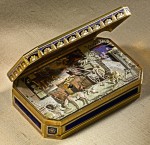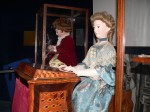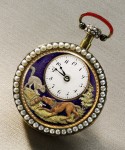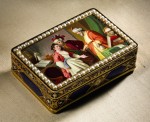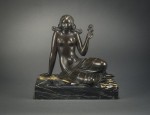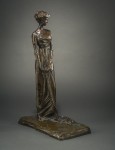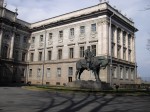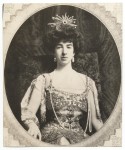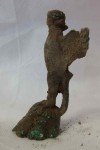This image has made the rounds of a couple of sites (io9, Bleeding Cool) the past few days and it’s so damn cool I had to get on the bandwagon. This article will be factually accurate, however. The other pieces say the original art is for sale at ComicLink, but it’s not. ComicLink sold it in 2006 for $75,000. It’s one of their record sales, so they have a link to the description from the 2006 sale on their homepage. There’s no date under the homepage thumbnail or on the description, which I guess is why the other writers got confused. It was obvious to me that it’s a past sale since the description had no purchase options or auction link anywhere and the homepage noted the $75,000 sale price.
Besides, that price is downright modest. It more than doubled between the work’s first appearance at auction in 2002 when it went for a bargain $33,350 and the sale four years later. There is no way this gorgeous piece of art complete with key notes about the character’s design from Wonder Woman original artist H.G. Peter and creator Dr. William Moulton Marston would go for less than six figures today.
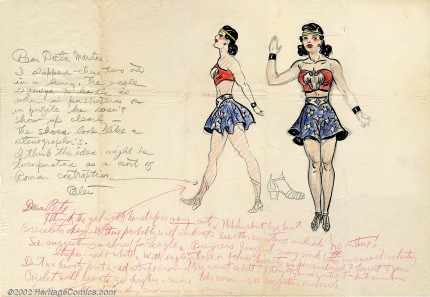
The note in pencil on the left side is from H.G. Peter to William Marston.
“Dear Dr. Marston, I slapped these two out in a hurry. The eagle is tough to handle – when in perspective or in profile, he doesn’t show up clearly – the shoes look like a stenographer’s. I think the idea might be incorporated as a sort of Roman contraption. Peter”.
The note underneath the drawing in red is Marston’s response:
“Dear Pete – I think the gal with hand up is very cute. I like her skirt, legs, hair. Bracelets okay + boots. These probably will work out. See other suggestions enclosed. No on these + stripes — red + white. With eagle’s wings above or below breasts as per enclosed? Leave it to you. Don’t we have to put a red stripe around her waist as belt? I thought Gaines wanted it – don’t remember. Circlet will have to go higher – more like crown – see suggestions enclosed. See you Wednesday morning – WMM.”
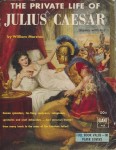 Gaines is Max Gaines, co-founder of All-American Publications, who had hired Marston after reading an interview with him in the October 25th, 1940, issue of The Family Circle magazine entitled “Don’t Laugh at the Comics.” Marston was a Harvard-educated psychologist (that’s where the Dr. came from), the inventor of the polygraph machine (that’s where Wonder Woman’s Lasso of Truth came from), and the author of a bondage-heavy erotic historical novel called Venus with Us later reissued as The Private Life of Caesar. Gaines saw in him an opportunity to add some scholarly heft to his stable of writers, an important virtue during a time when comics were under constant attack from psychologists and other assorted pearl-clutchers raving against the influence of these lurid picture-books on malleable young minds.
Gaines is Max Gaines, co-founder of All-American Publications, who had hired Marston after reading an interview with him in the October 25th, 1940, issue of The Family Circle magazine entitled “Don’t Laugh at the Comics.” Marston was a Harvard-educated psychologist (that’s where the Dr. came from), the inventor of the polygraph machine (that’s where Wonder Woman’s Lasso of Truth came from), and the author of a bondage-heavy erotic historical novel called Venus with Us later reissued as The Private Life of Caesar. Gaines saw in him an opportunity to add some scholarly heft to his stable of writers, an important virtue during a time when comics were under constant attack from psychologists and other assorted pearl-clutchers raving against the influence of these lurid picture-books on malleable young minds.
 Marston had been making headlines for years with demonstrations of his lie detector (he campaigned vigorously without success for Bruno Hauptmann to be polygraph tested before he was executed for the kidnapping and murder of the Lindbergh baby) and his unconventional views on the relations between the sexes. As early as 1931 newspapers reported with aghast titillation on a survey he did as a visiting professor of psychology at Long Island University which purportedly demonstrated that women in college were abandoning the pose of “Victorian timidity” and deliberately cultivating a “red hot baby” reputation, thus reversing the age-old gender roles of hunter and hunted in sexual pursuit. The men weren’t pleased with this change, according to Marston, because they prefer to be “unhappy masters” rather than “happy slaves.”
Marston had been making headlines for years with demonstrations of his lie detector (he campaigned vigorously without success for Bruno Hauptmann to be polygraph tested before he was executed for the kidnapping and murder of the Lindbergh baby) and his unconventional views on the relations between the sexes. As early as 1931 newspapers reported with aghast titillation on a survey he did as a visiting professor of psychology at Long Island University which purportedly demonstrated that women in college were abandoning the pose of “Victorian timidity” and deliberately cultivating a “red hot baby” reputation, thus reversing the age-old gender roles of hunter and hunted in sexual pursuit. The men weren’t pleased with this change, according to Marston, because they prefer to be “unhappy masters” rather than “happy slaves.”
In 1937 he asserted confidently in a lecture in New York that “the next 100 years will see the beginning of an American matriarchy — a nation of Amazons in the psychological rather than physical sense. In 500 years, there will be a serious sex battle. And in 1,000 years, women will definitely rule this country.” The AP picked up the story and from there it spread to newspapers all over the continent.
In 1939 he determined WITH SCIENCE that gentlemen in fact prefer brunettes. The conclusion was based on a survey of 20,000 men and, Marston contended, it’s all because of the endocrine glands.
“Too much thyroid secretion in your blood, for example, may make your eyes pop out and turn your hair white, then make you bald. This same overdose of thyroid will give you a tense, nervous, sleepless, irritable fear-haunted personality. These subtle chemicals which influence your personality so profoundly reveal their presence by the colors they produce in your skin.� For this reason, a girl’s hair becomes a flag which nature compels her to fly, revealing to all who understand the endocrine code her controlling personality traits.”
Therefore, the brunette is the “natural man conqueror.”
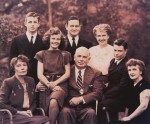 Dr. Marston practiced what he preached. He was married to Elizabeth Holloway Marston, a psychologist and lawyer who had defied her father to pay her way through Boston University School of Law and who continued to work with much success and to other people’s consternation after she bore their two children. He also had a lover, writer Olive Byrne, who lived with the couple. It was Byrne, incidentally, under the pseudonym Olive Richards, who interviewed Marston for the fateful The Family Circle story that caught Gaines’ eye.
Dr. Marston practiced what he preached. He was married to Elizabeth Holloway Marston, a psychologist and lawyer who had defied her father to pay her way through Boston University School of Law and who continued to work with much success and to other people’s consternation after she bore their two children. He also had a lover, writer Olive Byrne, who lived with the couple. It was Byrne, incidentally, under the pseudonym Olive Richards, who interviewed Marston for the fateful The Family Circle story that caught Gaines’ eye.
Byrne had two children with Marston who were officially adopted by the married pair, but they all lived together as a single family. When Marston became ill first from polio and then with cancer, Elizabeth supported the family while Olive stayed home taking care of the children and their ailing father. Elizabeth continued to provide for Olive and the children after Marston’s death in 1947, ensuring all the kids received a college education. Marston’s widows, one de jure and one de facto, lived together until Olive’s death in the 1980s. By all accounts, including those of the Marston children, the arrangement worked for them and they were a close-knit, loving, happy family before and after William’s death.
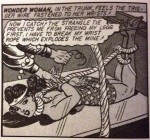 It was Elizabeth’s idea for Marston to make his new superhero a woman, an idea that suited him to a T. Marston’s vision of the brunette amazon who makes happy slaves of men easily crossed over from psychology lectures to comic books in the form of Wonder Woman. Olive apparently inspired her look. His bondage fetish — so thoroughly explored in Venus with Us — dominated, as it were, the early issues of Wonder Woman comics. She gets chained or tied up in pretty much every issue, then returns the favor. For a riveting exploration of Marston’s personal and professional life and the early BDSM days of Wonder Woman, read Jill Lepore’s The Secret History of Wonder Woman. It is a page-turner of the highest order.
It was Elizabeth’s idea for Marston to make his new superhero a woman, an idea that suited him to a T. Marston’s vision of the brunette amazon who makes happy slaves of men easily crossed over from psychology lectures to comic books in the form of Wonder Woman. Olive apparently inspired her look. His bondage fetish — so thoroughly explored in Venus with Us — dominated, as it were, the early issues of Wonder Woman comics. She gets chained or tied up in pretty much every issue, then returns the favor. For a riveting exploration of Marston’s personal and professional life and the early BDSM days of Wonder Woman, read Jill Lepore’s The Secret History of Wonder Woman. It is a page-turner of the highest order.
Marston laid it all out, for those with eyes to see, in a 1944 article he wrote for The American Scholar, the journal of the Phi Beta Kappa Society. Hyperbolically titled Why 100,000,000 Americans Read Comics (that figure is not a typo; he included some trumped-up, extrapolated stats to support the contention), the article sings the praises of the visual medium, connects comic book heroes to Homeric progenitors like Achilles and Ulysses, and relays a backstory (minus any references to Elizabeth and Olive) of how the Wonder Woman comic came to be.
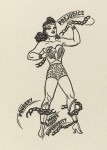
 It’s smart to be strong. It’s big to be generous. But it’s sissified, according to exclusively masculine rules, to be tender, loving, affectionate, and alluring. “Aw, that’s girl stuff!” snorts our young comics reader. “Who wants to be a girl?” And that’s the point; not even girls want to be girls so long as our feminine archetype lacks force, strength, power. Not wanting to be girls they don’t want to be tender, submissive, peaceloving, as good women are. Women’s strong qualities have become despised because of their weak ones. The obvious remedy is to create a feminine character with all the strength of a Superman plus all the allure of a good and beautiful woman. This is what I recommended to the comics publisher.
It’s smart to be strong. It’s big to be generous. But it’s sissified, according to exclusively masculine rules, to be tender, loving, affectionate, and alluring. “Aw, that’s girl stuff!” snorts our young comics reader. “Who wants to be a girl?” And that’s the point; not even girls want to be girls so long as our feminine archetype lacks force, strength, power. Not wanting to be girls they don’t want to be tender, submissive, peaceloving, as good women are. Women’s strong qualities have become despised because of their weak ones. The obvious remedy is to create a feminine character with all the strength of a Superman plus all the allure of a good and beautiful woman. This is what I recommended to the comics publisher.
My suggestion was met by a storm of mingled protests and guffaws. Didn’t I know that girl heroines had been tried in pulps and comics and, without exception, found failures? Yes, I pointed out, but they weren’t superwomen, they weren’t superior to men in strength as well as in feminine attraction and love-inspiring qualities. Well, asserted my masculine authorities, if a woman hero were stronger than a man, she would be even less appealing. Boys wouldn’t stand for that; they’d resent the strong gal’s superiority. No, I maintained, men actually submit to women now, they do it on the sly with a sheepish grin because they’re ashamed of being ruled by weaklings. Give them an alluring woman stronger than themselves to submit to and they’ll be proud to become her willing slaves!
 A family in Lecce, an ancient city on the tip of Italy’s boot heel, found a veritable historical complex under their feet when they began digging to find a faulty sewer pipe in 2000. Luciano Faggiano family had acquired the building at Via Ascanio Grandi 56 planning to use the first floor as a trattoria and live with his wife and youngest son upstairs. It was a historical property — part of the convent of Santa Maria delle Curti which was closed in the 17th century and the remains of whose cells are still visible in the first floor walls — but renovated with all modern conveniences. When one of those conveniences, the toilet, kept backing up, Faggiano enlisted his two older sons who no longer live at home to spend a week helping him dig underneath the house to find the broken sewer pipe causing the problem.
A family in Lecce, an ancient city on the tip of Italy’s boot heel, found a veritable historical complex under their feet when they began digging to find a faulty sewer pipe in 2000. Luciano Faggiano family had acquired the building at Via Ascanio Grandi 56 planning to use the first floor as a trattoria and live with his wife and youngest son upstairs. It was a historical property — part of the convent of Santa Maria delle Curti which was closed in the 17th century and the remains of whose cells are still visible in the first floor walls — but renovated with all modern conveniences. When one of those conveniences, the toilet, kept backing up, Faggiano enlisted his two older sons who no longer live at home to spend a week helping him dig underneath the house to find the broken sewer pipe causing the problem.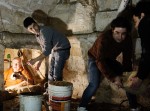 Faggiano kept digging, removing the spoil in the trunk of his car, even tying a rope around the chest of his 12-year-old son to lower him into passages that were too small for the adults. Mrs. Faggiano was not informed of this. Eventually the neighbors got suspicious and called the cops. Since unapproved archaeological excavations are illegal, even when the original aim was sewer maintenance, the authorities blocked the dig for a year until making a deal with the Faggianos that they could continue under the supervision of archaeologists from the local Superintendence of Archaeological Goods and architects Franco and Maria Antonietta De Paolis.
Faggiano kept digging, removing the spoil in the trunk of his car, even tying a rope around the chest of his 12-year-old son to lower him into passages that were too small for the adults. Mrs. Faggiano was not informed of this. Eventually the neighbors got suspicious and called the cops. Since unapproved archaeological excavations are illegal, even when the original aim was sewer maintenance, the authorities blocked the dig for a year until making a deal with the Faggianos that they could continue under the supervision of archaeologists from the local Superintendence of Archaeological Goods and architects Franco and Maria Antonietta De Paolis.  More than 4,000 artifacts have been unearthed during the decade-plus of digging. They did find the sewer pipe after a few years, by the way, and it was broken. By then, of course, the trattoria idea was back-burnered and Luciano Faggiano rented one of the floors in the building to help fund this voyage of exploration through the layers of Lecce’s history. He’s still planning to open a trattoria, but in a new building. This one is now the Museum Faggiano where people can go down into the bowels of the structure to see the ancient history for themselves.
More than 4,000 artifacts have been unearthed during the decade-plus of digging. They did find the sewer pipe after a few years, by the way, and it was broken. By then, of course, the trattoria idea was back-burnered and Luciano Faggiano rented one of the floors in the building to help fund this voyage of exploration through the layers of Lecce’s history. He’s still planning to open a trattoria, but in a new building. This one is now the Museum Faggiano where people can go down into the bowels of the structure to see the ancient history for themselves.